| Varying fortunes of the bedonkohe apaches |
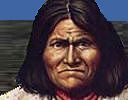 |
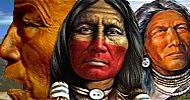 |
|
|
|
||
| N'de, Dinė, Tinde, Inde or "The People" |
| |
Varying fortunes of the bedonkohe apaches |
Artifact Replicas|Jewelry|Clothing|Figurines|On Sale|New ProductsVarying fortunes of the bedonkohe apachesA chapter excerpted from the autobiography of Geronimo. Source: As told by Geronimo, Public Domain Documents In the fall of 1865 with nine other warriors I went into Mexico on foot. We attacked several settlements south of Casa Grande, and collected many horses and mules. We made our way northward with these animals through the mountains. When near Arispe we made camp one evening, and thinking that we were not being trailed, turned loose the whole herd, even those we had been riding. They were in a valley surrounded by steep mountains, and we were camped at the south of this valley so that the animals could not leave without coming through our camp. Just as we had begun to eat our supper our scouts came in and announced Mexican troops coming toward our camp.  Indian Marauders Buy this poster at Art.com Be sure to check out the custom frame link for mounting and framing options. Find out how you can use this image for FREE! We started for the horses, but troops that our scouts had not seen were on the cliffs above us, and opened fire. We scattered in all directions, and the troops recovered all our booty. In three days we reassembled at our appointed place of rendezvous in the Sierra Madre Mountains in northern Sonora. Mexican troops did not follow us, and we returned to Arizona without any more fighting and with no booty. Again I had nothing to say, but l was anxious for another raid. Early the next summer (1866) I took thirty mounted warriors and invaded Mexican territory. We went south through Chihuahua as far as Santa Cruz, Sonora, then crossed over the Sierra Madre Mountains, following the river course at the south end of the range. We kept on westward from the Sierra Madre Mountains to the Sierra de Sahuripa Mountains, and followed that range northward. We collected all the horses, mules, and cattle we wanted, and drove them northward through Sonora into Arizona. Mexicans saw us at many times and in many places, but they did not attack us at any time, nor did any troops attempt to follow us. When we arrived at home we gave presents to all, and the tribe feasted and danced. During this raid we had killed about fifty Mexicans. Next year (1867) Mangus-Colorado led eight warriors on a raid into Mexico. I went as a warrior, for I was always glad to fight the Mexicans. We rode south from near Tombstone, Arizona, into Sonora, Mexico. We attacked some cowboys, and after a fight with them, in which two of their number were killed, we drove all their cattle northward. The second day we were driving the cattle, but had no scouts out. When we were not far from Arispe, Mexican troops rode upon us. They were well armed and well mounted, and when we first saw them they were not half a mile away from us. We left the cattle and rode as hard as we could toward the mountains, but they gained on us rapidly. Soon they opened fire, but were so far away from us that we were unable to reach them with our arrows; finally we reached some timber, and, leaving our ponies, fought from cover. Then the Mexicans halted, collected our ponies, and rode away across the plains toward Arispe, driving the cattle with them. We stood and watched them until they disappeared in the distance, and then took up our search for home. We arrived home in five days with no victory to report, no spoils to divide, and not even the three ponies which we had ridden into Mexico. This expedition was considered disgraceful. The warriors who had been with Magnus Colorado on this last expedition wanted to return to Mexico. They were not satisfied, besides they felt keenly the taunts of the other warriors. Magnus Colorado would not lead them back, so I took command and we went on foot, directly toward Arispe in Sonora, and made our camp in the Sierra de Sahuripa Mountains. There were only six of us, but we raided several settlements (at night), captured many horses and mules, and loaded them with provisions, saddles and blankets. Then we turned to Arizona, traveling only at night. When we arrived at our camp we sent out scouts to prevent any surprise by Mexicans, assembled the tribe, feasted, danced, and divided the spoils. Mangus Colorado would not receive any of this booty, but we did not care. No Mexican troops followed us to Arizona. About a year after this (1868) Mexican troops rounded up all the horses and mules of the tribe not far from our settlement. No raids had been made into Mexico that year, and we were not expecting any attacks. We were all in camp, having just returned from hunting. About two o'clock in the afternoon two Mexican scouts were seen near our settlement. We killed these scouts, but the troops got under way with the herd of our horses and mules before we saw them. It was useless to try to overtake them on foot, and our tribe had not a horse left. I took twenty warriors and trailed them. We found the stock at a cattle ranch in Sonora, not far from Nacozari, and attacked the cowboys who had them in charge. We killed two men and lost none. After the fight we drove off our own stock and all of theirs. We were trailed by nine cowboys. I sent the stock on ahead and with three warriors stayed in the rear to intercept any attacking parties. One night when near the Arizona line we discovered these cowboys on our trail and watched them camp for the night and picket their horses. About midnight we stole into their camp and silently led away all their horses, leaving the cowboys asleep. Then we rode hard and overtook our companions, who always traveled at night instead of in the daytime. We turned these horses in with the herd and fell back to again intercept anyone who might trail us. What these nine cowboys did next morning I do not know, and I have never heard the Mexicans say anything about it. I know they did not follow us, for we were not molested. When we arrived in camp at home there was great rejoicing in the tribe. It was considered a good trick to get the Mexicans' horses and leave them asleep in the mountains. It was a long time before we again went into Mexico or were disturbed by the Mexicans.

Arctic Wolf Art Print Bjorlin, Eric Buy at AllPosters.com Framed Mounted |
What's New in the Gallery Store: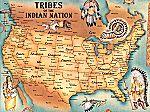 Native American Tribes by States Poster 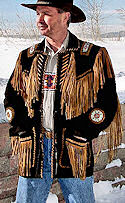 25 new fringed leather jackets 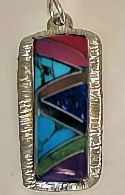 Zuni Style inlaid stone jewelry More New Products |
||||||||||||||||||||||||||||||||||||||||||||||||||||||||||||
Apache chastity and marriage Apache customs regarding courtship, marriage and divorce. Wives and burial place of Geronimo A detailed list of all the wives of Gernonimo and his burial place. Why do we yell "Geronimo"? Learn the legend behind this phrase. Apache tribal amusements, manners, and customs As explained by Geronimo in the telling of his life story.
| |
| Back to Top |Shipping & Return Policies |Customer Testimonials |Site Map |Affiliate Program |Privacy Policy |Contact Us | Submissions |